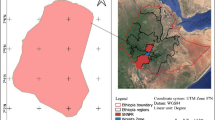Abstract
As an uncertain reasoning model, the general C-F model was originally developed for processing the uncertainties of rule-based knowledge in the field of artificial intelligence. In this model, certainty factors and combined certainty factors are defined and used for expressing the strengths of knowledge rules and knowledge rule combinations, respectively. The certainty factor can reflect the believable degree of inferring hypothesis on the basis of a proof. Similarly, the combined certainty factor can reflect the believable degree of inferring hypothesis on the basis of the proof combination. It is a function of the related certainty factors and can be determined through combining the certainty factors via the combining rule of the general C-F model. In this paper, the general C-F model has been successfully applied to mineral resource potential mapping. We call this model as the applied form of the general C-F model. In this applied form, the certainty factor is applied to expressing the believable degree of inferring mineral occurrence on the basis of one of the map pattern states associated with the mineral occurrence. Correspondingly, the combined certainty factor is applied to expressing the believable degree of inferring the mineral occurrence on the basis of the map pattern state association. And it is also applied to expressing mineral resource potentials in the mineral resource potential mapping. In the current form, the first step in implementing the general C-F model is to estimate a pair of certainty factors for each map pattern under combination. The next step is to determine the combined certainty factor for the map pattern states coexisting in each locality of the mapping area. The last step is to generate the combined-certainty-factor raster map or the combined-certainty-factor contour map in order to select mineral resource targets. The applied form of the general C-F model is demonstrated on a case study to select mineral resource targets. The experimental results manifest that the model can be compared with the weights-of-evidence model in the effectiveness of mineral resource target selection.
Similar content being viewed by others
REFERENCES
Agterberg, F. P., 1974, Automatic contouring of geological maps to detect target areas for mineral exploration: Math. Geol., v.6, no.4, p. 373-395.
Agterberg, F. P., 1989, LOGDIA-FORTRAN 77 program for logistic regression with diagnostics: Comput. Geosci., v.15, no.4, p. 599-614.
Agterberg, F. P., 1990, Combining indicator patterns for mineral resource evaluation, in China University of Geosciences (eds.), Proceedings of international workshop on statistical prediction of mineral resources, Vol.1: Wuhan, China, p. 1-15.
Agterberg, F. P., 1992, Combining indicator patterns in weights-of-evidence modeling for resource evaluation: Nonrenewable Res., v.1, no.1, p. 39-50.
Agterberg, F. P., Bonham-Carter, G. F., and Wright, D. F., 1990, Statistical pattern integration for mineral exploration, in Gaal G. and Merriam, D. F. (eds.), Computer applications for mineral exploration in resource exploration: Pergamon Press, Oxford, p. 1-21.
Liu, D. Y., 2000, Numerical methods for treating uncertainty and vagueness in knowledge-based systems: Jilin University Press, Changchun, 280p. (In Chinese).
Pan, G. C., 1993a, Canonical favorability model for data integration and mineral potential mapping, Comput. Geosci., v.19, no.8, p. 1077-1100.
Pan, G. C., 1993b, Indicator favorability theory for mineral potential mapping, Nonrenewable Resour., v.2, no.4, p. 292-311.
Pan, G. C., 1996, Extended weights-of-evidence modeling for the pseudo-estimation of metal grades, Nonrenewable Resour., v.5, no.1, p. 53-76.
Wu, Q. Y., and Liu, J. N., 1995, Artificial intelligence and expert systems: University of National Defence Sciences and Technologies Press, Changsha, 260. p. (In Chinese).
Wang, W. S., 2000, Principles and applications of artificial intelligence: Publishing House of Electronic Industry, Beijing, 291. p. (In Chinese).
Zhou, G. Y., and Xia, L. X., 1993, Nonquantitative data analysis and its application: Science Press, Beijing, 295. p. (In Chinese).
Author information
Authors and Affiliations
Rights and permissions
About this article
Cite this article
Chen, YL. Indicator Pattern Combination for Mineral Resource Potential Mapping with the General C-F Model. Mathematical Geology 35, 301–321 (2003). https://doi.org/10.1023/A:1023870231452
Issue Date:
DOI: https://doi.org/10.1023/A:1023870231452




